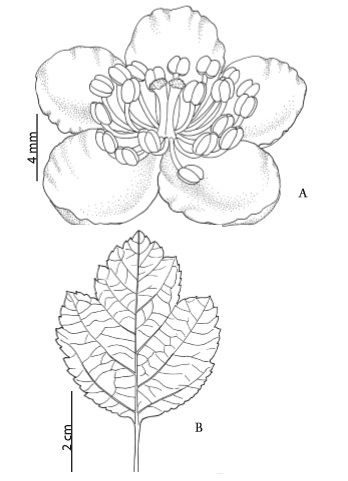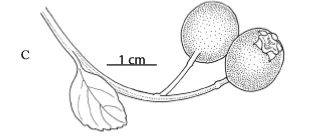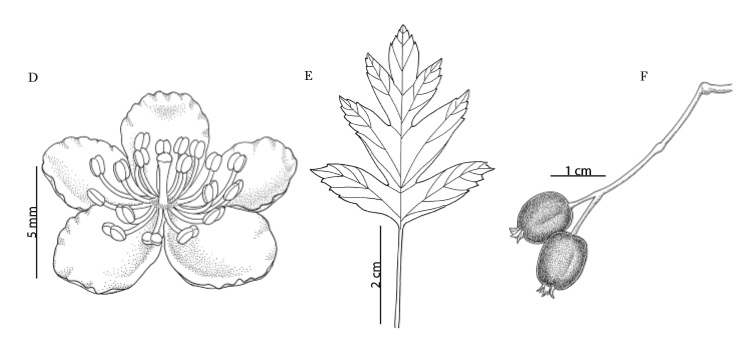Crataegus
laevigata (Poiret) DC, C.
monogyna Jacq.
Standardized Common
Name: Hawthorn
Other Common Names: English Hawthorn,
Haw, May Tree, One-seed Hawthorn (C. monogyna)
Family: Rosaceae
Taxonomy: Crataegus
includes perhaps 200 to 250 species of shrubs and small trees, all native to
temperate parts of the Northern Hemisphere. The species of Crataegus are
highly variable and species boundaries are arguable; as a result, the
nomenclature is exceedingly complex. Several dozen species-level synonyms refer
to each of these two species, both of which belong to Sect. Crataegus.
The name C. oxyacantha L., commonly used for C. laevigata, has
been officially rejected due to a history of incorrect usage.
Hybridization
among these and other species is extremely common, and hybrid populations often
are named as nothospecies. The hybrid between C. laevigata and C.
monogyna may be called C. ×media Bechstein; such
hybridization is nearly ubiquitous where the species’ ranges overlap. Likewise,
hybridization with several other species is recognized and commonplace,
resulting in gene flow from other species into the parent populations. Probably
few “pure” populations of any species, according to the current species
concept, have ever existed.
Description: Shrub or small tree
to 8–10 m high, usually bearing indeterminate thorns. Leaves alternate,
stipulate, petiolate; shape variable within species, often depending on
position on plant, with those on flowering shoots less lobed; upper surface
dark green; lower surface pale, more or less soft-pubescent at least on major
veins and in vein axils. Inflorescence a corymb, 3–15-flowered, glabrous or
pubescent; flowers subtended by linear deciduous bracts; pedicels short to >3
cm long. Hypanthium green, to 4 mm long, glabrous or pubescent. Sepal lobes 5,
triangular, often pubescent near apex. Petals 5, white (or dark red in a few
cultivars). Stamens numerous; anthers purple. Ovary inferior. Fruit a drupe,
red with yellowish flesh, glabrous or pubescent, with persistent sepal lobes at
apex; pyrenes usually equal in number to styles, longitudinally grooved on both
dorsal and ventral sides.
Crataegus
laevigata:
Thorns 1–2 cm long or absent. Leaves 2–7 cm long, 1.5–5 cm broad, broadly ovate
to rhomboid or suborbicular, with (0–)1–2(–3) pairs of shallow lateral lobes,
often all above the midpoint of the leaf; leaves on short shoots narrower and
more conspicuously lobed than those on flowering shoots; margins coarsely
serrate; apices of lobes obtuse, toothed; base cuneate or somewhat rounded;
upper surface more or less soft-pubescent along main veins. Sepal lobes 0.9–2.8
mm long, 1.4–2.6 mm broad; apices acute to round-tipped. Petals 5–10 mm long,
5–9 mm broad. Styles (1–)2–3(–5). Fruit subglobose to broadly ellipsoidal, 6–14
mm long.
Crataegus
monogyna:
Thorns to 2.5 cm long. Leaves 1–6 cm long, 1–6 cm broad, broadly ovate, deltoid
or suborbicular or rarely obovate, with 1–4 pairs of deeply incised lateral
lobes, the lowest usually below the midpoint of the leaf, except leaves on
flowering shoots sometimes bearing only shallow apical lobes; margins serrate
with 1–several teeth per lobe or entire; apices of lobes obtuse or acute; base
attenuate or cuneate; upper surface pubescent with soft hairs or glabrous.
Sepal lobes 1.2–4.4 mm long, 1.2–2.6 mm broad; apices acute to obtuse. Petals
3–7 mm long, 4–7 mm broad. Styles 1(–2). Fruit subglobose to cylindrical, 6–11
mm long.
Parts
in Commerce:
Leaves and flowers, sometimes with fruits, or fruits alone
Identification: These two commonly
employed species of Crataegus share several character states which may
differ in other species, including the following:
Leaves
- Mostly lobed,
<7 cm long
- With dark green
upper surface and pale or grayish green lower surface
- Main veins
usually straight, extending from midrib to lobe tips and also to sinuses
between lobes
- Petioles
distinct, not extremely short
- Taste weak,
slightly sweet and bitter
Floral
bracts
falling off early (therefore often not observed), small, narrow and toothed;
not elliptical nor with glandular margins
Flowers
- Hypanthium 2–4
mm long
- Sepal lobes 5,
broadly triangular; margins entire, not toothed or glandular
- Petals 5, white
or dark red in a few cultivars
- Anthers purple,
occasionally dark pink to red; not pink, yellow or white
Fruits
- Fruit a drupe,
containing pyrenes or “nutlets” (seeds surrounded by a hard coat), with
persistent calyx lobes at apex
- Red at maturity,
not yellow, orange, deep purple, or black
- Flesh yellow,
dry and mealy; not juicy, not red, orange or green
- Pyrenes with
grooved outer and inner surfaces, not with smooth or pitted inner surface
- Taste slightly
sweet, mucilaginous
The
following table shows characters that vary between C. laegivata and C.
monogyna, together with alternative character states that may be found in
undesired species.
|
|
C. laevigata
|
C. monogyna
|
States
found only in other species
|
|
Leaf
shape
|
Most
w/ 1–3 pairs of shallow lobes, usually confined to apical half of leaf
|
Most
with 1–4 pairs of deeply incised lobes, usually the lowest in basal half of
leaf
|
4–9
lobes per leaf or leaves all unlobed
|
|
Leaf
surfaces
|
Often
with soft straight hairs along main veins, and in vein axils on underside
|
Hairy
along main veins and in axils below, both surfaces sometimes hairy
|
|
|
Leaf
margins
|
Coarsely
serrate, usually with at least several teeth per lobe
|
One
or a few large teeth per lobe
|
Entire,
or with glands on the teeth
|
|
Inflorescences
|
3–11-flowered,
loose with long pedicels, usually glabrous
|
4–15-flowered,
loose with long pedicels
|
15–50-flowered
|
|
Sepal
shape
|
Triangular;
0.9–2.8 mm long, 1.4–2.6 mm broad
|
Triangular;
1.2–4.4 mm long, 1.2–2.6 mm broad
|
Linear
or outside size range of desired species
|
|
Petals
|
5–10
mm X 5–9 mm
|
3–7
mm X 4–7 mm
|
Outside
size range
|
|
Stamen
number
|
17–22
|
15–20
|
<12
|
|
#
of styles
|
(1–)2–3(–5)
|
1(–2)
|
4–6,
or more than expected
|
|
Fruit
shape, size
|
6–14
mm long, almost spherical to broadly ellipsoidal
|
6–11
mm long, almost spherical to cylindrical
|
<6
mm or 15–35 mm long; narrowly elliptical or pear-shaped; with an angular base
|
|
Persistent
calyx
|
Sepal
lobes reflexed or spreading
|
Sepal
lobes reflexed
|
Sepal
lobes erect
|
|
Fruit
surface
|
Bright
red, usually hairless or with soft straight hairs
|
Glossy
to deep red, with or without hairs
|
Not
red, or with a waxy coating
|
|
Pyrenes
|
(1–)2–3(–5)
per fruit
|
1
(rarely 2) per fruit
|
4–6
per fruit
|
Hybrid
populations carrying genetic material of both C.
laevigata and C.
monogyna may appear intermediate between the two parental species.
Likewise, hybridization with or introgression of other species may produce
similar effects.
Adulterants: Other European
hawthorns that are commonly used medicinally include C. douglasii Lindl.
(Black Hawthorn), C. nigra Waldst. & Kit., C. pentagyna
Waldst. & Kit. ex Willd., and C. rhipidophylla Gandoger (the species
to which C. oxyacantha L. properly applied). All should be
distinguishable by combinations of the above characters.
According
to Herbs of Commerce, the North American C. rivularis Nutt. (aka C.
douglasii var rivularis (Nutt.) Sarg.), a black-fruited species with
10 stamens, and C. piperi Britton (aka C. chrysocarpa var piperi
(Britton) Kruschke) may be sold interchangeably with the above two species
under the name of Hawthorn in North America. Features of the latter include:
- Leaves rhomboid,
with short shallow lobes appearing biserrate
- Leaf teeth and
pedicels glandular
- Calyx lobes
narrow
- Stamens 10;
anthers ivory-colored
- Fruits spherical,
ca. 10 mm in diameter, salmon-orange to red
- Pyrenes 3–4 per
fruit
This
circumscription of “Hawthorn” seems inadequately justified. The above two
species, although traditionally used in their own right, are not among the
closest relatives of the species used in European traditional medicine (and in
most clinical trials), nor have they been demonstrated to possess the same
(numerous but poorly characterized) therapeutic compounds in greater measure
than more closely related species.
References:
British Herbal Medicine
Association. British Herbal Pharmacopoeia. BHMA; 1996:98–99.
Byatt JI. Hybridization between Crataegus
monogyna Jacq. and C. laevigata (Poiret) DC. in south-eastern
England. Watsonia. 1975;10:253–264.
Christensen KI. Revision of Crataegus
Sect. Crataegus and Nothosect. Crataeguineae (Rosaceae—Maloideae)
in the Old World. Ann Arbor, MI: American Society of Plant Taxonomists;
1992. Systematic Botany Monographs, vol. 35.
Phipps JB. Introduction to the red-fruited hawthorns
(Crataegus, Rosaceae) of western North America. Can J Bot.
1998;76:1863–1899.
Wells TC, Phipps JB. Studies in Crataegus
(Rosaceae: Maloideae). XX. Interserial hybridization between Crataegus
monogyna (series Oxycanthae) and Crataegus punctata (series Punctatae)
in southern Ontario. Can J Bot. 1989;67:2465–2472.
Wichtl M, ed. Herbal Drugs and
Phytopharmaceuticals, 3rd English
ed. Stuttgart: medpharm Scientific Publishers and Boca Raton, FL: CRC Press;
2004:152–158.



Figure 21: a–c, Crataegus
laevigata leaf, flower and
fruit; d–f, C. monogyna leaf, flower
and fruit.